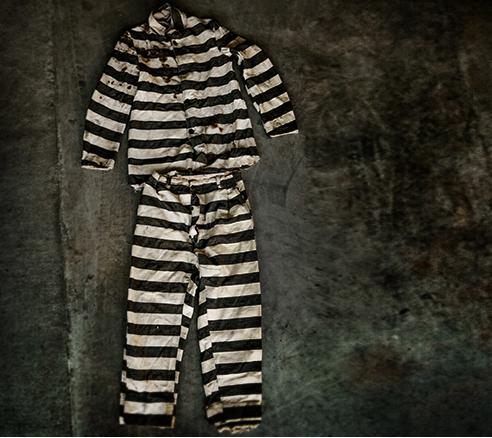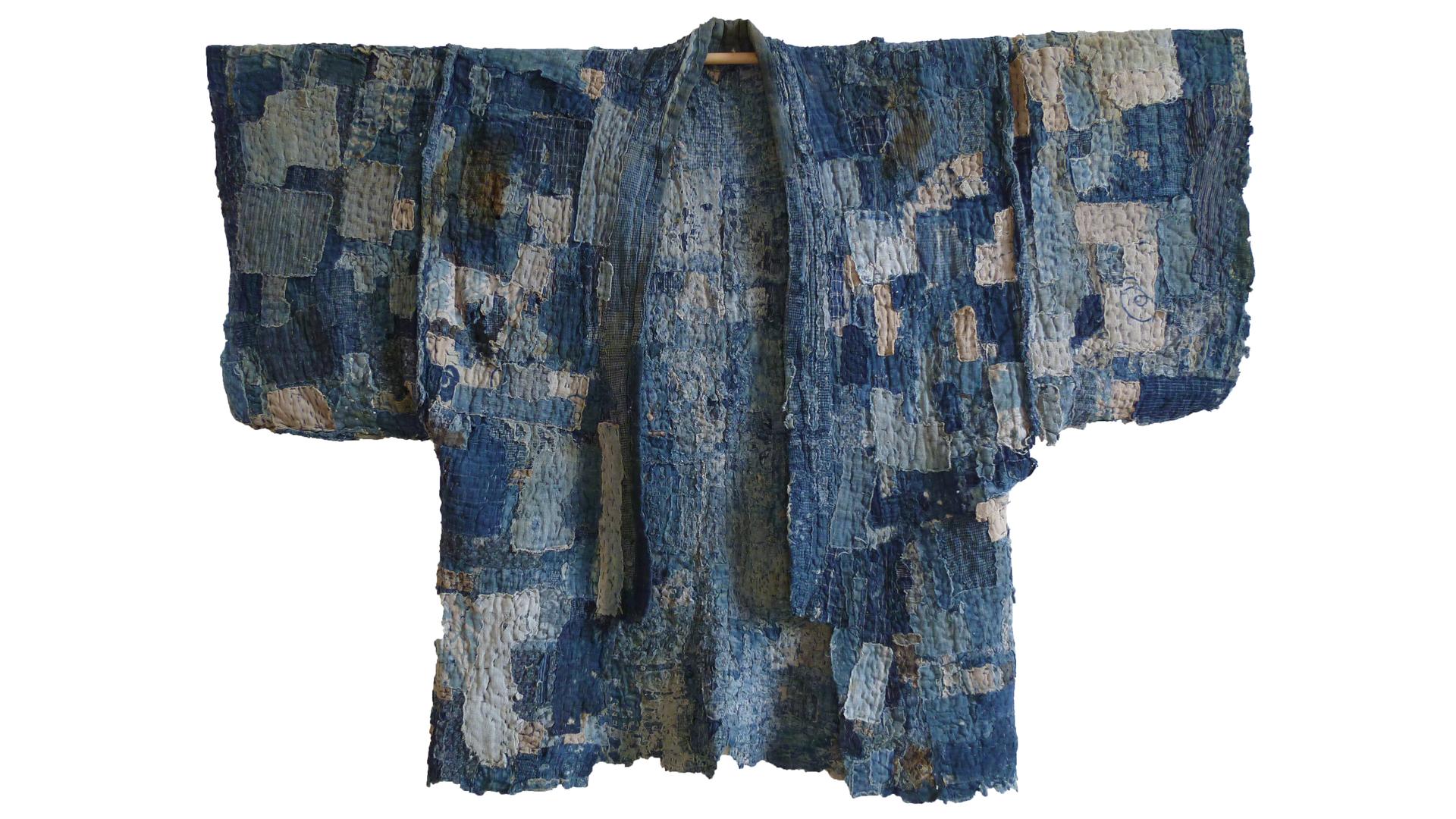Some Japanese will pay $4,500 for an old Missouri prisoner uniform. Me, I collect Japanese ‘boro’
This is a patched work coat, or noragi, that likely never began as a full garment, but was rather made from multiple, very small patches — some of them the size of a postage stamp — that were all sewn together to create an area of cloth, and then layered.
It’s amazing how a casual choice of words can change your perspective when it comes to used clothing.
Calling that sweater a “hand-me-down” invites flashbacks to tragic dances in a junior high gym. Call it “vintage” or “consignment” all of a sudden makes it hipster chic.
But what if you call it “antique clothing for the body?”
“I can sometimes hear people off the street saying, they’ve got dirty t-shirts hanging in that window.”
That’s Melissa Howard talking about her inventory at Stock Vintage in Manhattan.
“A good majority of people would say, ‘wow, this is like a beat-up t-shirt that one would throw away,’” she says. “These are very difficult to find, just plain white cotton t-shirts that have holes that someone naturally made or sometimes color-distressing, not armpit stains. But to me, I see the beauty in that.”
You won’t find any bespoke suits from Savile Row at Melissa’s shop. These are castoffs from America’s working poor — farmers, factory workers, truckers. Even inmates.
“I recently acquired a prisoner’s outfit from the 1940s and it came from Joplin, Missouri. It’s very unusual to find a prisoner’s outfit because people tend not to preserve prisoner’s outfits, just because, for the obvious reasons,” she says. “What’s unique about this particular piece is the man was actually shot in prison and you can see the bullet holes in the back of the jacket. I have the jacket and the pants.”
 Believe it or not, people actually buy these clothes to wear, not just to collect them. But what’s even more surprising is who buying them.
Believe it or not, people actually buy these clothes to wear, not just to collect them. But what’s even more surprising is who buying them.
“Boy, I would say anywhere from 30-50 percent of my buyers are Japanese,” Melissa says.
Thanks to Japan’s passion for American workwear, jeans are the new kimono. After World War II, denim was a cheap military surplus good, as a sexy as a hand-me-down. But iconic Hollywood movies like Rebel without a Cause raised denim to cult status in Japan.
Today, you can take a bus tour down “Jeans Street” in Kojima, where many world-class denim makers are based.
Less well known is the small, but passionate group of Americans — myself included — who feel the same way about Japanese vintage workwear.
My friend Stephen Szczepanek is the owner of Sri Threads, a Japanese textile gallery in Greenpoint, Brooklyn. It’s filled with indigo kimonos, noragi jackets and aprons, all of them handmade from rags, carefully patched and repatched to a point that transcends function and approaches the sublime.
The Japanese refer to this kind of clothing as “boro,” which means tattered or broken. And as Szczepanek explains, the look had nothing to do with fashion. Workers wanted cotton to keep warm.
“They couldn’t afford to buy it as a finished garment, but they bought the scraps and put it back together again and that’s why it looks like it looks, this kind of visual cacophony that’s kind of cohesive at the same time.”
 The “broken” clothing of Japanese farmers and fishermen sounds like a really esoteric, niche thing, but Szczepanek’s clients include some of the biggest names in the American fashion industry. And once you see boro, you’ll notice its influence everywhere — from mass-produced rugs, to last year’s Luis Vuitton men’s collection.
The “broken” clothing of Japanese farmers and fishermen sounds like a really esoteric, niche thing, but Szczepanek’s clients include some of the biggest names in the American fashion industry. And once you see boro, you’ll notice its influence everywhere — from mass-produced rugs, to last year’s Luis Vuitton men’s collection.
So what’s with this American/Japanese dual fascination with each other’s heirloom clothing?
“I think it has to do with a kind of romanticism,” says Stephen. “When you don’t understand something, you can bring your own sense of nostalgia to it, which is maybe completely misplaced. But I do think that when I look at this stuff, for example, I dream about those days in old Japan. Very much like, I think, Japanese vintage denim dealers have this kind of cinematic view of the Old West.”
Hisashi Oguchi, a co-owner of Hickorees, a menswear store in Brooklyn that’s launching their own hybrid Japanese/American line of jeans, agrees with Szczepanek’s theory of misplaced nostalgia.
“We have a similar association to the frontier spirits of America,” Hisashi says.
Until 150 years ago, he tells me, Japan was a feudal system, ruled by a shogun family who promoted an austere, simple lifestyle — really not so far from the self-sustainable ethos in vogue today.
“Workers simple life, looking for better life – That’s sort of my opinion about how Japanese people got so attracted to it. It’s like we lost that, in this modern day Japan. All of that is gone.”
Those days are gone in the US too. A 100 years ago, Americans just burned old clothes they couldn’t use anymore.
Today, the prison uniform hanging in the window of Stock Vintage sells for $4,500. Melissa tells me these are exactly the one-of-a-kind items that bring her Japanese buyers to the US.
Worthless or priceless: It’s not just how you look at it. It’s where you come from.
A show featuring Szczepanek’s collection of boro textiles is opening at the Museum of Design and Fashion in Lisbon, Portugal in October.
It’s amazing how a casual choice of words can change your perspective when it comes to used clothing.
Calling that sweater a “hand-me-down” invites flashbacks to tragic dances in a junior high gym. Call it “vintage” or “consignment” all of a sudden makes it hipster chic.
But what if you call it “antique clothing for the body?”
“I can sometimes hear people off the street saying, they’ve got dirty t-shirts hanging in that window.”
That’s Melissa Howard talking about her inventory at Stock Vintage in Manhattan.
“A good majority of people would say, ‘wow, this is like a beat-up t-shirt that one would throw away,’” she says. “These are very difficult to find, just plain white cotton t-shirts that have holes that someone naturally made or sometimes color-distressing, not armpit stains. But to me, I see the beauty in that.”
You won’t find any bespoke suits from Savile Row at Melissa’s shop. These are castoffs from America’s working poor — farmers, factory workers, truckers. Even inmates.
“I recently acquired a prisoner’s outfit from the 1940s and it came from Joplin, Missouri. It’s very unusual to find a prisoner’s outfit because people tend not to preserve prisoner’s outfits, just because, for the obvious reasons,” she says. “What’s unique about this particular piece is the man was actually shot in prison and you can see the bullet holes in the back of the jacket. I have the jacket and the pants.”
 Believe it or not, people actually buy these clothes to wear, not just to collect them. But what’s even more surprising is who buying them.
Believe it or not, people actually buy these clothes to wear, not just to collect them. But what’s even more surprising is who buying them.
“Boy, I would say anywhere from 30-50 percent of my buyers are Japanese,” Melissa says.
Thanks to Japan’s passion for American workwear, jeans are the new kimono. After World War II, denim was a cheap military surplus good, as a sexy as a hand-me-down. But iconic Hollywood movies like Rebel without a Cause raised denim to cult status in Japan.
Today, you can take a bus tour down “Jeans Street” in Kojima, where many world-class denim makers are based.
Less well known is the small, but passionate group of Americans — myself included — who feel the same way about Japanese vintage workwear.
My friend Stephen Szczepanek is the owner of Sri Threads, a Japanese textile gallery in Greenpoint, Brooklyn. It’s filled with indigo kimonos, noragi jackets and aprons, all of them handmade from rags, carefully patched and repatched to a point that transcends function and approaches the sublime.
The Japanese refer to this kind of clothing as “boro,” which means tattered or broken. And as Szczepanek explains, the look had nothing to do with fashion. Workers wanted cotton to keep warm.
“They couldn’t afford to buy it as a finished garment, but they bought the scraps and put it back together again and that’s why it looks like it looks, this kind of visual cacophony that’s kind of cohesive at the same time.”
 The “broken” clothing of Japanese farmers and fishermen sounds like a really esoteric, niche thing, but Szczepanek’s clients include some of the biggest names in the American fashion industry. And once you see boro, you’ll notice its influence everywhere — from mass-produced rugs, to last year’s Luis Vuitton men’s collection.
The “broken” clothing of Japanese farmers and fishermen sounds like a really esoteric, niche thing, but Szczepanek’s clients include some of the biggest names in the American fashion industry. And once you see boro, you’ll notice its influence everywhere — from mass-produced rugs, to last year’s Luis Vuitton men’s collection.
So what’s with this American/Japanese dual fascination with each other’s heirloom clothing?
“I think it has to do with a kind of romanticism,” says Stephen. “When you don’t understand something, you can bring your own sense of nostalgia to it, which is maybe completely misplaced. But I do think that when I look at this stuff, for example, I dream about those days in old Japan. Very much like, I think, Japanese vintage denim dealers have this kind of cinematic view of the Old West.”
Hisashi Oguchi, a co-owner of Hickorees, a menswear store in Brooklyn that’s launching their own hybrid Japanese/American line of jeans, agrees with Szczepanek’s theory of misplaced nostalgia.
“We have a similar association to the frontier spirits of America,” Hisashi says.
Until 150 years ago, he tells me, Japan was a feudal system, ruled by a shogun family who promoted an austere, simple lifestyle — really not so far from the self-sustainable ethos in vogue today.
“Workers simple life, looking for better life – That’s sort of my opinion about how Japanese people got so attracted to it. It’s like we lost that, in this modern day Japan. All of that is gone.”
Those days are gone in the US too. A 100 years ago, Americans just burned old clothes they couldn’t use anymore.
Today, the prison uniform hanging in the window of Stock Vintage sells for $4,500. Melissa tells me these are exactly the one-of-a-kind items that bring her Japanese buyers to the US.
Worthless or priceless: It’s not just how you look at it. It’s where you come from.
A show featuring Szczepanek’s collection of boro textiles is opening at the Museum of Design and Fashion in Lisbon, Portugal in October.
